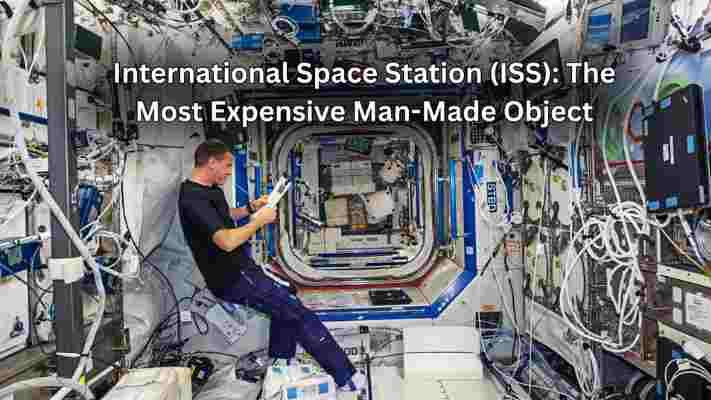Why the International Space Station (ISS) is the most expensive man-made object, its cost, purpose, global impact, and life in orbit.
International Space Station (ISS) The Most Expensive Man-Made Object

The International Space Station (ISS) is more than a monster sky science laboratory, it is the most expensive man made object that has ever been built. The ISS is a memorial to international collaboration, scientific research, and human endeavour in an orbit high above the Earth.
So, let us see why the ISS is so super special, how costly it is, what goes on there and why it stands as one of the most amazing scientific projects in history.
What Is the International Space Station?
The International Space Station is a colossal space ship that is in the process of orbiting around the Earth at approximately 400 kilometers (250 miles) off us. It is some kind of a house and research station where astronauts spend months of their life. It travels at a speed of 28000km/h and it does one circuit around the earth in 90minutes.
Built by Countries Around the World
The ISS is an international project that includes space agencies from:
● NASA (United States)
● Roscosmos (Russia)
● ESA (European Space Agency)
● JAXA (Japan)
● CSA (Canada)
The construction process started in 1998, and various sections of the station were launched into orbit and assembled gradually.
How Expensive Is the ISS?
The cost estimate of the ISS is approximately $150 billion, the most costly object ever made by humans.
Here's the breakdown:
● Construction and assembly: $100 billion
● Maintenance and support: $50 billion
●
Operational cost per year: Approximately
$3–4 billion annually
Although the price tag is expensive, the scientific significance and global cooperation it generates is worth it.
What Is the ISS Used For?
The ISS has been used mostly as a scientific research platform, a platform of demonstration of space technology, and training of missions to other places. This is what transpires on board:
1. Scientific Research
Astronauts conduct experiments in the field of biology, physics, chemistry, and medicine, as well as in other disciplines. Research on microgravity allows us to be able to find answers to discover things that we cannot find on earth.
2. Space Technology Testing
The ISS serves as a trial facility of new space equipment, tools and technology that will be applicable in future missions to the Moon or Mars.
3. Earth and Space Observation
ISS contains cameras and sensors to observe the weather, oceans, and the climatic conditions of the earth. It monitors space phenomena such as cosmic rays and solar flares.
4. Educational Outreach
The ISS is utilized so as to inspire the students and promote science education on an international basis. In fact, astronauts do video conferences regularly with schools and even hold lessons in space.
Who Lives on the ISS?
The ISS typically has a crew of 6 astronauts who hail from various nations. They remain for 3 to 6 months. Some popular astronauts who have resided on the ISS are:
● Chris Hadfield (Canada)
● Sunita Williams (USA)
● Peggy Whitson (USA)
● Yuri Malenchenko (Russia)
Their daily schedule is:
● Conducting experiments
● Keeping the station operational
● Exercising for 2 hours daily to remain healthy in space
● Communicating with mission control on Earth
How Do Astronauts Get to the ISS?
Astronauts travel to the ISS in spacecraft such as:
● SpaceX Crew Dragon (USA)
● Soyuz capsule (Russia)
● Boeing Starliner (in testing phase)
The ISS has docking facilities where these spacecraft can dock, deliver crew and cargo, and finally leave for Earth.
Life on the ISS: What’s It Like?
Living on the ISS is nothing like living on Earth:
●
There is no gravity, so
the astronauts float across the station.
●
They sleep in tiny pods
hanging from the wall.
●
They eat space food —
special food stored in pouches.
●
They use specially
adapted toilets and must recycle water.
●
The Internet exists, but
communication is slightly delayed because of the distance.
Astronauts say it is the experience of a lifetime despite challenges.
How Long Will the ISS Stay in Space?
Later it was projected that ISS would service to 2020 but the service was lengthened to 2030. Then, it may be:
●
Emergency
stopped and just discarded in the sea
●
Displace
advances replaced with newer space
stations (national or private)
●
Moon or Mars mission training facility
Why Is the ISS Important?
The significance of the ISS is like this:
1. Global Cooperation
It is one of the few cases where nations tried to collaborate peacefully in space.
2. Scientific Progress
It assists scientists to invent superior medicines, materials, and technologies.
3. Future of Space Travel
ISS acts as a launchpad for future deep space missions.
4. Inspiration
It encourages millions of students to think big and become professionals in the field of STEM (science, technological, engineering, and math).
Fun Facts About the ISS
●
The ISS is as big as a
football field.
●
It contains 6 sleeping
compartments, 2 toilets, a gymnasium, and a laboratory.
●
It moves at 5 miles per
second.
●
It is equipped with
solar panels for power.
●
You can spot the ISS
using the naked eye from Earth. It appears as a moving, bright star in the sky.
Frequently Asked Questions (FAQs)
Q1. Why is the ISS so expensive?
A: It is constructed on high-technology materials that are launched in sections with the help of rockets and guarded by astronauts. It has to constantly be supported by the Earth as well.
Q2. Who owns the ISS?
A: It is not owned by one country. It is operated and shared by various space agencies such as that of NASA, Roscosmos, ESA, JAXA and CSA.
Q3. Can normal people go to the ISS?
A: It is quite costly, yes, but it is. The ISS has been visited by some technicians who are citizens (such as space tourists) and have paid millions of dollars.
Q4. Is the ISS visible from Earth?
A: Yes. You will observe it without a telescope. Your place can be tracked by NASA and other websites.
Q5. What will replace the ISS in the future?
A: Companies that are privately owned such as SpaceX and Blue Origin plan to erect new space stations. Others such as China already possess their own (Tiangong).
Final Words
The International Space Station is more than a space lab — it is a historic leap for humanity. With a price tag that is the highest among all man-made objects, and one of the most advanced, the ISS continues to educate, inform, and prepare us for the future of space travel.
If you're a space fanatic, a student, or just simply curious, the tale of the ISS reveals that we can achieve great things if the entire world comes together for the same dream.

Sed ac lorem felis. Ut in odio lorem. Quisque magna dui, maximus ut commodo sed, vestibulum ac nibh. Aenean a tortor in sem tempus auctor
Agatha Christie
December 4, 2020 at 3:12 pm

Sed ac lorem felis. Ut in odio lorem. Quisque magna dui, maximus ut commodo sed, vestibulum ac nibh. Aenean a tortor in sem tempus auctor
Steven
December 4, 2020 at 3:12 pm

Donec in ullamcorper quam. Aenean vel nibh eu magna gravida fermentum. Praesent eget nisi pulvinar, sollicitudin eros vitae, tristique odio.
Danielle Steel
December 4, 2020 at 3:12 pm





Vestibulum euismod, leo eget varius gravida, eros enim interdum urna, non rutrum enim ante quis metus. Duis porta ornare nulla ut bibendum
Rosie
6 minutes ago